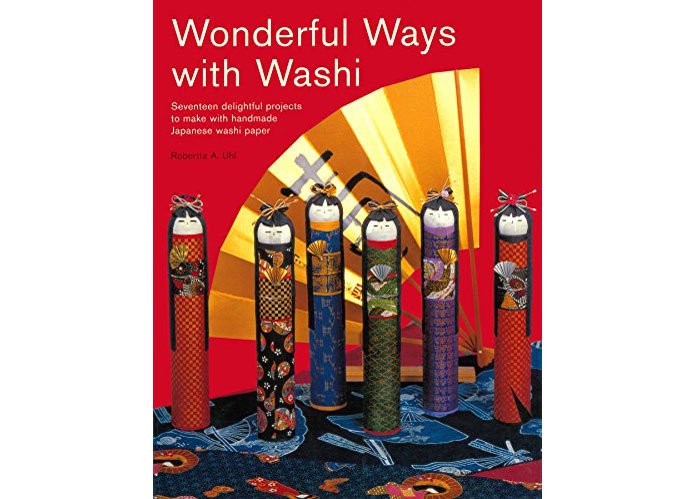Japanese Washi Tape: Everything You Need to Know

© Tsutsumu, Washi Paper Stationery
Washi paper is one of of Japan’s most fundamental, and often overlooked, artistic products. During 1,300 years of production it has formed the backbone of many other Japanese artforms. In fact washi paper is so ingrained in Japanese culture, there are literally towns build around washi paper making.
In the most basic of terms, washi paper simply means traditional Japanese paper, wa (和) meaning Japanese and shi (紙) meaning paper. From its eclectic history, through its many uses, to the key travel destinations in Japan, there are many fascinating things to learn and a lot to be said about this richly historic and still relevant art. Here we’ll cover everything you need to know about washi paper. Strap yourself in, because it’s a deceptively diverse world.
1. What is Washi Paper?
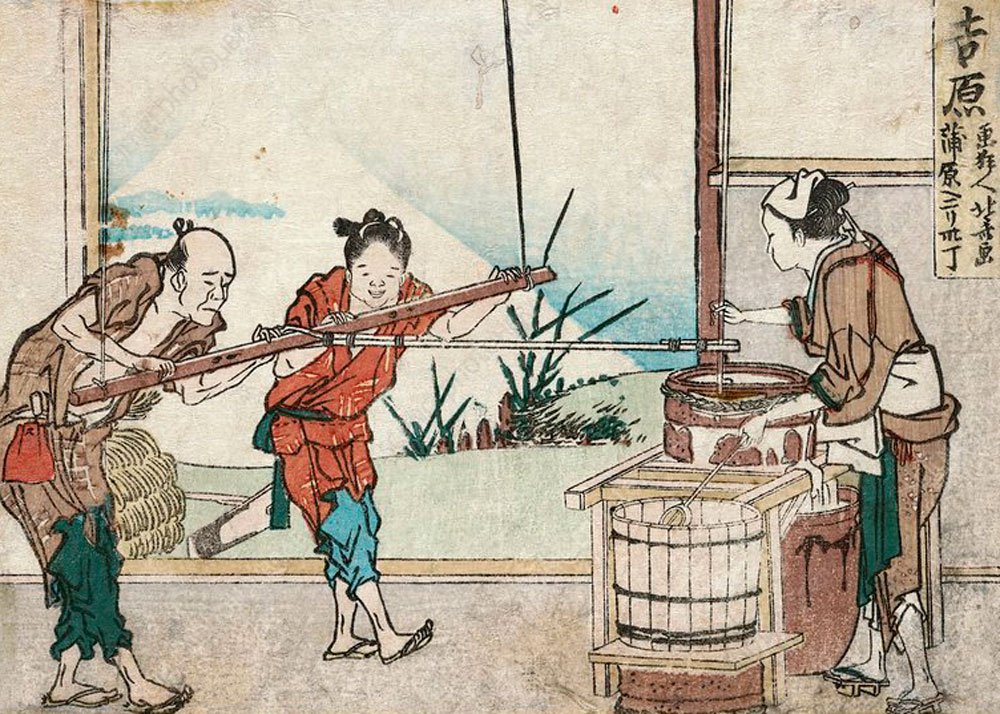
Making Paper in 1804, by Katsushika Hokusai
Although today it’s baked into the core of Japan’s cultural arts, the roots of washi paper production can be traced back to China. Seafaring voyagers from the Asian mainland were the catalyst for many cultural booms in ancient Japan, and paper was just another element in a long line of groundbreaking introductions. It was around 610 CE that the technique of making paper by hand was brought to Japan by proselytizing Buddhist monks. They used it to write sacred sutras and to record the doctrinal beliefs of their mystical school of thought.
To add another international twist to washi paper’s origins, the Nihon Shoki, also known as The Chronicles of Japan, one of the oldest books on classical Japanese history (written in 720), claims that the Chinese techniques were brought to the country via the Korean Buddhist priest Doncho, who helpfully introduced techniques for making ink at the same time.
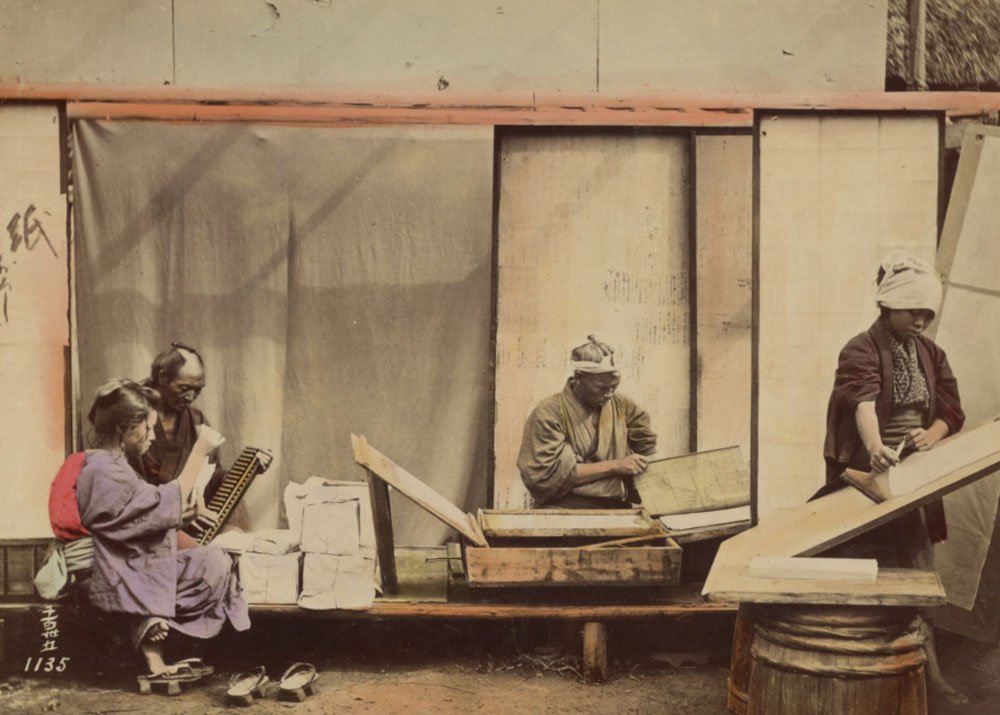
Making Paper in the 1870s, by Shinichi Suzuki, The J. Paul Getty Museum
As it has done so well and so repeatedly throughout history, Japan adopted an already complex crafting technique and iterated and improved upon it. Japan’s new washi paper-making technique involved adding more textiles and plant-based materials to the production process, such as kozo (mulberry) and gampi fibers. These helped to strengthen the paper, extend its longevity, and increase its versatility.
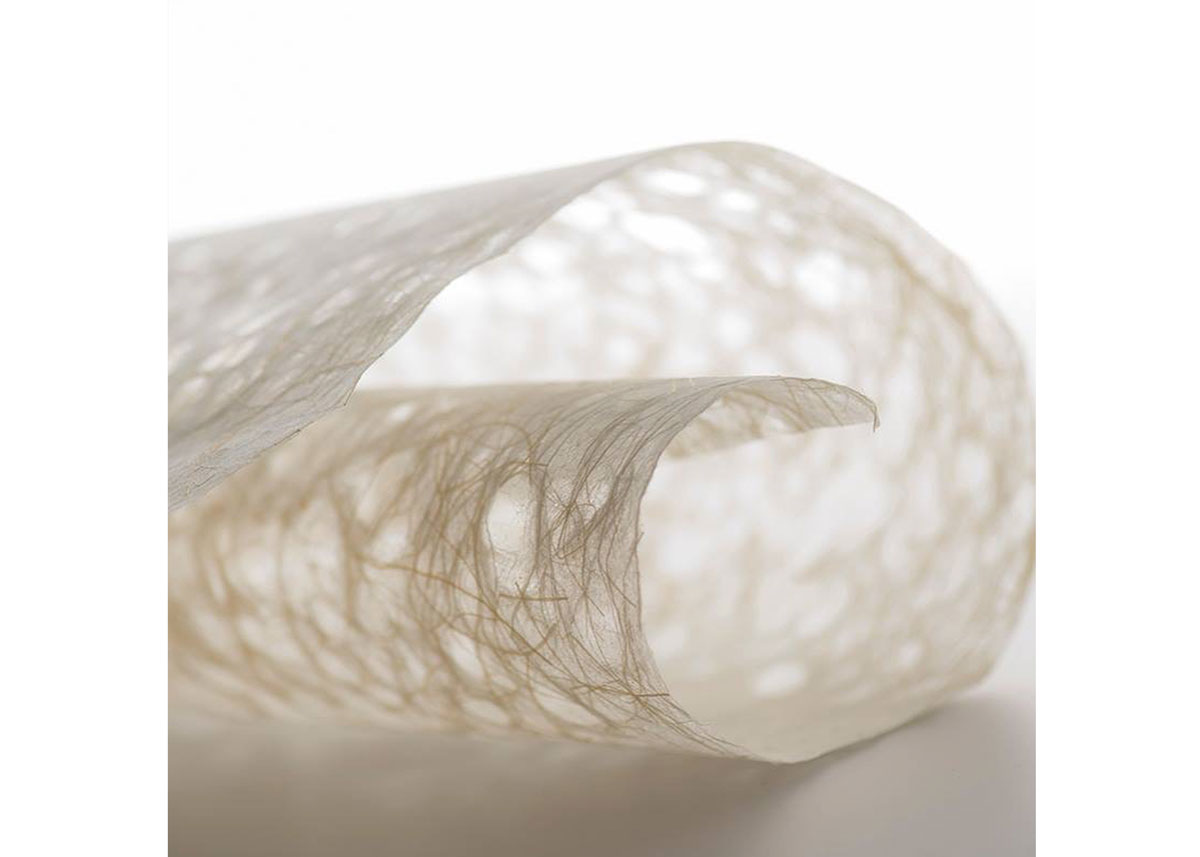
© Awagami Factory, Washi Paper Texture
Because Japanese paper-making depended on natural materials, the production of washi paper, like other agricultural activities, became seasonal. Winter was typically considered the best paper-making season as the weather was too cold for farmers to be toiling away in the arable fields and rice paddies. Washi manufacturers were also able to take advantage of winter ice, which they thawed to ensure the water they used was free from impurities and didn’t discolor the paper.
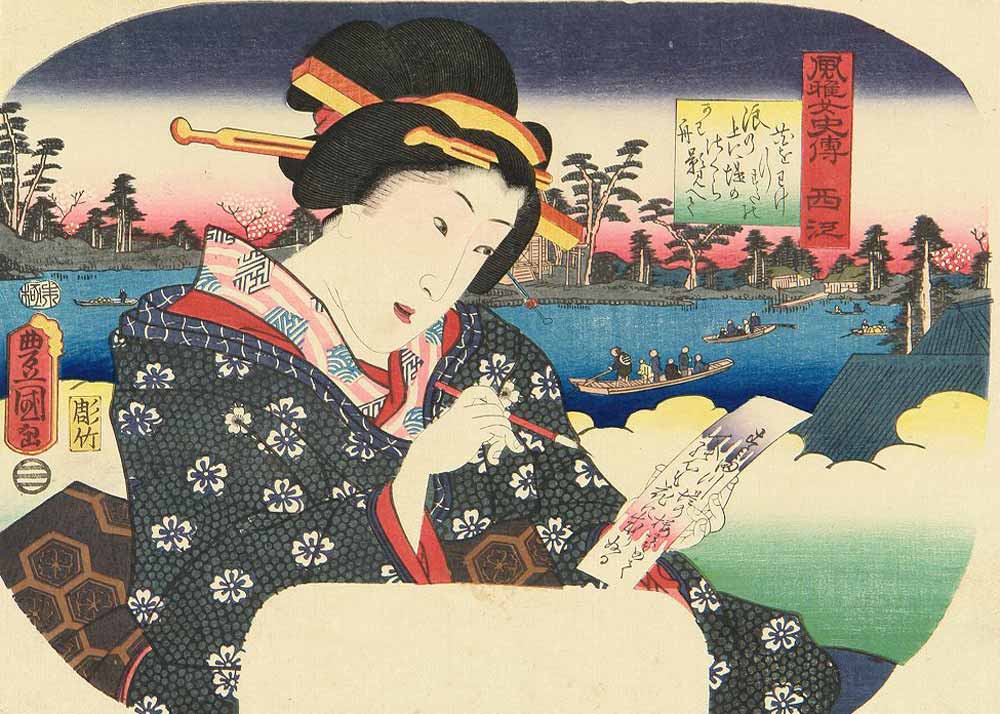
Writing a Poem, Woodblock Print by Utagawa Kunisada, 1859.
Handmade washi paper remained mainstream until the Meiji period (1868 – 1912) when Japan went through a process of Westernization. With increased Western influence came what was known as yoshi paper; essentially mass-produced, machine-made paper. From this period washi started to take a backseat and its role was relegated from everyday use to more artisanal and bespoke purposes.
2. How is Washi Paper made?
Ideally the perfect time of the year to make washi is the dead of winter, when water is naturally frozen and free from impurities, offering the freshest, most natural ingredients for paper making. The methods and materials will vary depending on what style of washi you’re going to make, because Japan’s various regions each have slightly different different techniques. That said, there is a general step-by-step procedure which functions as a guideline.
Harvesting: Firstly you need the materials for the paper. Most washi paper uses kozo, and mitsumata, two shrubs that are generally cultivated, and gampi which is typically wild. Usually these are harvested during the colder months of December and January.
Steaming, stripping and selecting: o separate the necessary parts of the plants, the branches must first be steamed. Once soft and ready to strip, the bark is carefully removed and dried. The dry bark is then boiled, and any impurities are spotted and removed. Following that, the pre-paper solution is beaten by hand to loosen fibers before it becomes a sheet.

© Awagami Factory, Making Sheets of Washi Paper
Sheeting: This is probably the most recognizable part of the process of making washi. This is when the pulpy paper solution is starting to take its final shape, albeit in a very loose form. From here the paper pulp is spread out onto a mat, and the mat is shaken to help the fibers become entwined. Once a desired size and thickness is reached, the excess water is poured off from the solution.

© Awagami Factory, Washi Paper Before Drying
Final steps: After being left to dry overnight, the almost ready-to-go sheets are subjected to a few more aesthetic steps before they reach their final washi form. The paper is pressed to remove any extra water, the sheets are then separated, brushed to remove any invasive textures and left again to complete the drying process in the sun. These large dry sheets form the foundation from which the washi is cut.
3. Types of Washi Paper
There are three main types of washi – though if we’re being pernickety, there are additional styles and further subcategorizations within each. The three styles are ganpishi, kozogami and mitsumatagami, each of which bears the name of its source plant.
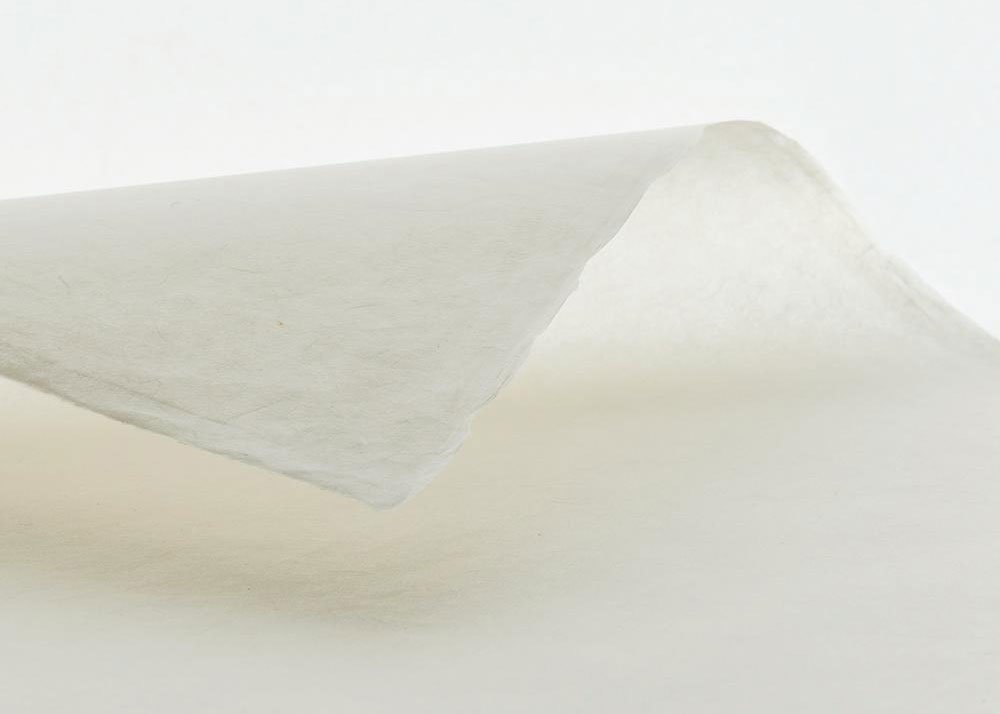
© Awagami Ganpishi Washi Paper
Ganpishi: Though ganpishi, made from the fibrous gampi plant, is not as common as other forms of wagashi, it is revered for its high quality. The paper’s glossy surface makes it resistant to insects and ageing whilst also lending itself nicely to the delicate brushwork used in paintings. It was also used as writing paper in the Heian courts and for gift-wrapping.

© Awagami Kozogami Washi Paper
Kozogami: Made from kozo, or mulberry, kozogami is the most common form of wagashi paper. It’s strong and durable properties meant it was used in book binding, as writing paper, and for crafting items such as wagasa umbrellas.

© Awagami Mitsumata Washi Paper
Mitsumata: The mitsumata plant, called Edgeworthia chrysantha or (more directly) Oriental paperbush in English, is a leathery, dark green shrub native to China. After it was introduced by travelers from the mainland, mitsumata was often used in paper production thanks to its strength and that it doesn’t crease easily.
4. What is Washi Used For?

© Awagami Washi Paper Artworks
In times gone by washi was used for practically everything modern machine-made paper is used for. Obviously as a handmade product, washi is more expensive than regular paper, so these days it has been displaced from some areas. However, there are still many purposes for which nothing but the most beautiful washi will do!

© Ito Shinsui, Bijin Magazine Cover, 1931
Printing and writing: Thanks to its thicker, more absorbent texture, washi is an excellent base for linoblock printing, colored lithographs, letterpress, embossing, and in more contemporary times, digital printing. Cards and wedding invitations, for example, are printed on washi to give them a certain elegance which standard paper cannot bestow. Washi postcards have also become increasingly common souvenirs.
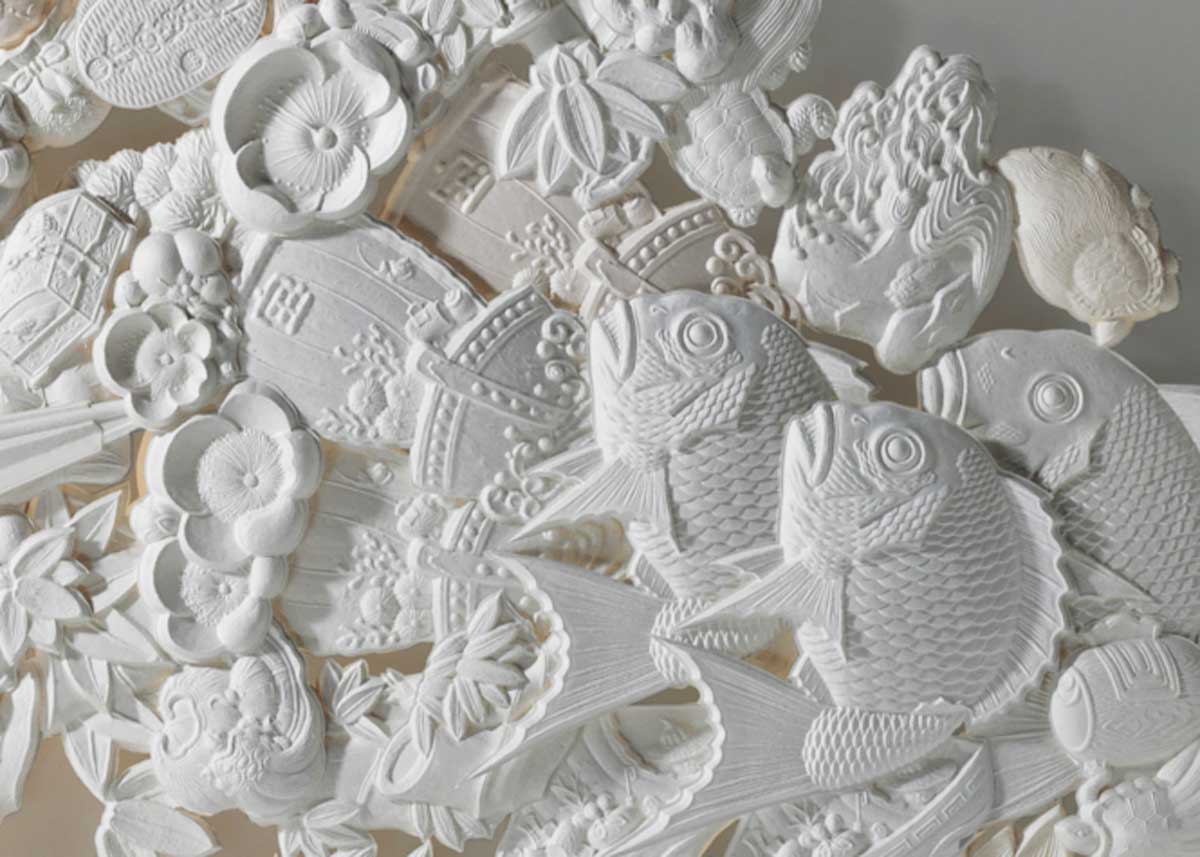
© Tetsuya Nagata, Washi Sculpture
Art: Many traditional artforms in Japan rely on washi. If you read our guide to Nihonga painting for example, you’ll see that using washi rather than canvas or modern paper is one of the elements that define this characteristically Japanese style. The particular texture of washi is essential for sumi-e (ink painting) too as it allows the right flow and absorbtion of the watery ink. For some artists, such as Tetsuya Nagata, the washi paper itself is the art in these incredible pressed washi sculptures. For more paper artists, check out these 14 Kiri-e Masters!
Bookbinding: Japan is a literature loving nation, so it’s no surprise really that washi and publishing go hand in hand. Rather than being used on the inside pages, washi is most typically used for book covers due to its durability and flexibility. Check out our selection of Japan’s best books available in English!

© Awagami Washi Paper Origami
Origami: With its sturdy, more malleable texture, washi paper is an excellent tool for origami. It retains its shape much better than other thinner origami papers. And of course, the unique look of washi lends its beauty to the finished object. To learn more, visit Origami 101: Helpful Tips & Easy Instructions for Beginners.

© Tottori Prefecture, Aoya Washi Kobo
Interior design: Due to its interesting, almost earthy textures and with a unique quality that sets off soft translucent light, washi has long been recognized as an ideal material for lamps, indoor screens, and more recently shutters and blinds. Its organic, natural feel is much more appealing visually than sterile mass-produced paper or other artificial materials.
5. Where to See Washi Paper Being Made?

Washi Paper Design, 1900s
Though we are long past the golden age of washi paper, there are still numerous producers across Japan. If you have the urge to learn more about washi paper-making, don’t miss the opportunity to visit these places:

© Nyao148 / Creative Commons, Washi no Sato
Washi no Sato (which in English literally translates to the village of washi paper) is located in the Chichibu district of north-west Saitama, a short day trip from Tokyo. The area produces hosokawa-shi, a style of washi paper that has been designated as a UNESCO Intangible Cultural Heritage. Artisans in the region have been making washi and unique tools for the production process since the Heian period, making it one of the most significant washi regions in the nation. A day trip gives visitors plenty of time to wander through the town, witness washi being made and pick up some paper to take home.

© Echizen Washi Village
Echizen Washi Village is another important washi destination, in Fukui Prefecture just north of Kyoto. The village has also been producing paper since it was introduced to Japan over 1,300 years ago. There are 67 paper-making mills scattered throughout the area whose products are sold in markets around the world – for wallpaper, sake labels, boutique wrapping paper, and more. As one of the few regions still making washi year-round, its importance has not been lost to the annals of history: the royal family still uses Echizen washi to formally announce the birth of a new child. When in the region, visitors should check out Udatu Paper and Craft Museum, situated in a mid-Edo era papermaker's house, as well as the Jiyomon and Shohachi paper studios.

© Qraud Hotel, Tosa Washi Paper
Tosa Washi, originating in its namesake Tosa Province in Kochi Prefecture, is a hotspot of washi production, especially paper produced for fusuma and shoji sliding door screens, and sometimes, for repairing old works of art. This translucent paper is typically rough on one side and smooth on the other, though it has as many as 300 different variations. The Niyodo River, which bisects Kochi Prefecture, is renowned for its clear waters and the mulberry and mitsumata plants which grow along its flanks. These natural resources have ensured Tosa has been a major washi region for around 1,000 years.

© Tsutsumu, Washi Paper Stationery
Mino washi, found in Mino City, Gifu Prefecture, was designated a Traditional Craft by the Ministry of Economy, Trade and Industry (METI) in 1985, and is often used in Japanese lanterns. Around the turn of the 13th century, the ruling Toki Clan of Mino Province promoted industry to help consolidate power in the region, with paper making becoming a central economic pillar (it has remained a major export of Mino City ever since). The town also has quintessentially Japanese old-style architecture, with sloping tiled rooves and wooden shop fronts in Mino-machi, the town centre. One can easily spend a weekend wandering through the streets and visiting all the perfectly preserved houses and stores, many of which sell Mino washi products, tools and other paper-related paraphernalia.
6. Where to Buy Washi Paper?

© Medeteya, Washi Paper
Though we have outlined the major washi paper regions above, you can also buy handmade paper and paper products in various stretches of the country:

© Kamiji Kakimoto, Washi Paper Store
If you’re in Kyoto, be sure to visit Kamiji Kakimoto, situated in the downtown area. This site is considered to be home to one of the best washi paper stores in Japan. Here you’ll find a broad selection of art and craft products including a very healthy stock of washi paper.
Another downtown Kyoto location is Wagaminomise Morita Washi. This incredibly well-stocked store sells everything from high end designer style washi to rough, lovable textured and rustic paper.

© Medeteya, Hina-sama
Visitors to Tokyo can head to the fourth floor of Loft stationery store in Kichijoji, where you will find Onao washi, a unique brand of traditional paper with modern flavor. Onao’s washi is used for daily use items, from writing paper to chopstick sleeves, and can also be purchased online or at stores in Tokyo’s Nihonbashi district and Yamanashi Prefecture, respectively (see website for details).
In Ginza, a glitzy downtown are rich in cultural traditions, you’ll find Kyukyodo. This shop, which sells its own brand of washi products, features a wide variety of crafted utensils: paintbrushes, incense sticks, paper fans, seasonal gifts and more.
Sitting by the harbor in Shinagawa is Pigment Tokyo, a treasure trove of traditional Japanese wares. Technically, Pigment it is an arts and crafts variety store, but along its gleaming shelves you’ll find some of the highest quality paper in Japan.

© Awagami Washi Paper Origami
If you’re outside of Japan, there are some great online washi shops too. The Awagami Factory, currently run by a sixth-generation paper master, has a wide selection of washi paper and other specialty papers, including machine-made mulberry papers, some of which are ink-jet printer compatible and perfect for contemporary uses (invitations, hand-written letters, decorations, etc.). You can order online from Japan, or check out their list of suppliers across the world.
Another site worth bookmarking is Washi Arts, home to a broad selection of paper products, many of which can be shipped within the US for just $5 or internationally for a slightly higher fee.
SIWA is a fantastic online washi-product brand, selling modernized items made with traditional techniques. Facemasks, tote bags, briefcases, wallets, and book covers feature in their fit-for-the-21st-century washi selection.
For all things Japanese paper, check out the Japanese Paper Place, which is particularly good for wholesalers and businesses looking to buy in bulk. Though they also export machine-made paper around the world, their real passion is sharing with the uninitiated the beauty of traditional handmade washi paper.
7. What Books about Washi Paper to Read?
Timothy Barret’s Japanese Papermaking: Traditions, Tools, Techniques is widely regarded as the most comprehensive book on washi paper. Fusing historical research with technical knowhow and in-depth DIY guidelines, this is the definitive entry point to one of Japan’s most widespread traditional arts.
Japanese Papermaking – Available at Amazon
Washi: The Art of Japanese Paper Making by Nancy Broadbent is first and foremost an illustrated history book tackling a particularly niche subject. But it also details the trajectory of washi over time, comparing Edo-period works to those from contemporary Kyoto.
Washi: The Art of Japanese Paper Making – Available at Amazon
Wonderful Ways with Washi is a fantastic DIY guidebook for making origami art with washi paper. Excellent for adults and children, novices and intermediates alike, the book outlines seventeen paper designs which can be displayed on objects in and around the household. Each design comes with illustrations and straightforward instructions.
8. Where to Find Out More About Washi Paper?

© Incho Paper Museum
If you’re still hungry to learn even more about the history, uses and incredibly unique forms of washi paper, here’s a run down of some of the best washi museums in the country. Happy paper hunting!
Ino-cho Paper Museum: Found in Kochi prefecture, this museum covers quite comprehensively the history of Tosa Washi, a local form of paper making that came into mainstream popularity over a thousand years ago. Today there are over 300 variations of Tosa Washi, many of which you’ll find here.
Mino-Washi Museum: The Mino-Washi Museum is Mino City’s main paper gallery. Beyond the historical significance of washi, here you’ll find detailed displays covering the contemporary times and the future of washi, as well as in-depth information on the techniques behind Mino washi production.
Paper Museum: This is Tokyo’s biggest paper museum, and one definitely worth visiting if you’ve got a little free time in the city. In addition to a well stocked store and impressive displays, this museum regularly runs paper making workshops. Classes are typically held on weekends, but you can visit the website for more details.
Is there anything more you’d like to know about washi? Let us know in the comments below.




